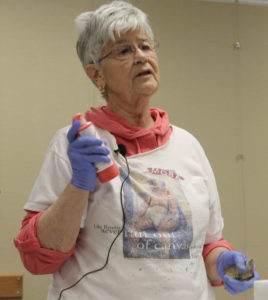By Page H. Gifford, Correspondent
Mixed media artist Susan Crave Rosen talked about her newfound love of art with members of the Fluvanna Art Association at their monthly meeting Oct. 19. While most gravitate toward art early in life, Rosen didn’t discover her inner artist until she had been a singer, musician and real estate agent.
Rosen said she always wanted to draw, then tried oils but couldn’t stand the fumes. For nearly eight years, she painted in watercolor and came to the realization that it takes a long time to master. Then she settled on acrylics. While aware of its limitations, she embraced its versatility in mixed media.
“What I wound up loving was the textures, shapes and lines in mixed media and collage,” she said. Kerrie Brown Burns inspired Rosen, and Brown’s influence shows in Rosen’s colorful abstract works. “You learn from people then develop your own style.”
She creates her one-of-a-kind pieces using tools that in most cases would be considered garbage, like old credit cards and a rubber washer with ridges she found on the street outside a movie theater. She uses these varied items in her designs.
Her first demonstration used an old credit card to sweep paint across a piece of clean paper. She used plain 50 lb drawing paper along with either acrylic paint or less expensive craft paints, which she prefers because of their flow on the paper.
The audience voiced concerns regarding the archival quality of the paper and paints. “Acrylic paints are plastic and hold up over time,” she said.
For paper, Rosen also likes art tissue, which is a little stronger than regular tissue paper and deli paper. These are thin papers she favors for collage.
She continued with her demonstration of making paper that she uses in her collages. After layering on her first color with the credit card she added another color for a blend of reds and fuchsia.
 She scrapes paint over textured items, which can include stencils or embossed wallpaper. To get the texture she used her previously painted paper, or a clean one can be used. She showed easy ways to print using simple techniques that are far less complex than other traditional printing methods, like silkscreen.
She scrapes paint over textured items, which can include stencils or embossed wallpaper. To get the texture she used her previously painted paper, or a clean one can be used. She showed easy ways to print using simple techniques that are far less complex than other traditional printing methods, like silkscreen.
Sometimes she takes her found objects, like the rubber washer with ridges, and dips them into paint she has spread on a palette, then presses them on the paper.
“Bubble wrap, sequin waste, corrugated cardboard, homemade and commercial stamps, jar lids and corks are few things that can be used to make shapes,” Rosen said. She then continued her demonstration using a brayer, a rubber roller used in printing, for a smoother coat of paint.
She explained that in monoprinting she adds glazing medium to the paint and mixes it in on the palette with a palette knife. She spreads the paint onto the paper, adds the textured item to the paint on the palette, removes the textured item from the palette, and presses the painted paper onto the palette to pick up the image.
Gelli plates allow artists to create paintings that look like graphic prints. She rolled her brayer through the paint-glaze mixture then transferred it to the Gelli plate. She then placed a stencil in the paint, put a sheet of paper on top and rubbed it with her hand or a baron, a round disc with a handle. Some use squeegees to smooth out the paper. She removed both the paper and stencil, then printed another on clean paper with a clean brayer.
Finally, she ended with making a transfer, which can be tricky.
“Choose a photo with high value contrasts from a magazine,” Rosen said. She proved that it is not wise to try using glossy paper, showig nothing transferred during the printing process. She began by putting a few dots of dark paint on the gel plate, then using her brayer she made a thin, even coat. She placed the image face down in the paint and pressed it down with her hand.
“It should transfer to the Gelli plate,” she said. She then added another light value of paint, smoothing it out with her brayer. She pressed a clean sheet of paper over the plate and pulled up the final print with the transferred image.
All these papers she utilizes in her collage designs. She lays them out on a gessoed canvas or wood board and lets her imagination run wild. For more information about Rosen and her work visit SusanCraveRosenArt.com.




